Birds
Media

Species Types
Scientific Name
Columba livia
Description
This is the common pigeon of city parks, downtown buildings, barns, and cliffs. Many color forms exist. The wild type has a dark head, breast, and shoulders, a light gray body, two dark bars on the wings, a white rump, and a dark band on the tip of the tail.
Media
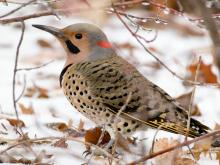
Species Types
Scientific Name
Colaptes auratus
Description
America’s flickers used to be considered three different species, but in the 1980s biologists determined otherwise. Now, our eastern “yellow-shafted” flicker, the “red-shafted” flicker of the west, and the “gilded flicker” of the southwest are all considered just forms of the same species: the northern flicker.
Media
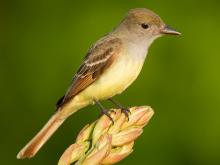
Species Types
Scientific Name
Myiarchus crinitus
Description
The great crested flycatcher spends most of its time high in trees. Learn its distinctive calls, and listen for it in summertime. It’s more common than you might think.
Media

Species Types
Scientific Name
Sayornis phoebe
Description
Eastern phoebes often build their mud-and-plant nests on the side of a house, just under a roof or other overhang. These small flycatchers repeatedly cry out their own name: “FEE-bee! FEE-bee!”
Media
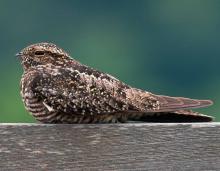
Species Types
Scientific Name
Chordeiles minor
Description
At night, common nighthawks fly, with quick flaps, glides, and darting movements, around lights pursuing flying insects. They are brown with a white mark on the underside of each narrow wing.
Media

Species Types
Scientific Name
Bombycilla cedrorum
Description
Sleek, crested cedar waxwings gather in large, relatively quiet groups to eat berries from shrubs and trees. The voice is a high-pitched, whizzy trill.
Media
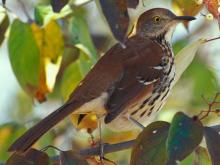
Species Types
Scientific Name
Toxostoma rufum
Description
The brown thrasher, named for the busy thrashes of its long tail, is closely related to the mockingbird and catbird. Like them, it mimics songs of other birds. It’s common in parks and yards.
Media

Species Types
Scientific Name
Charadrius vociferus
Description
The killdeer is a familiar “shorebird,” but we usually don’t see it near shores! Killdeer prefer open, flat, rather dry areas with short grass, including flooded crop fields, lawns, and sports fields.
Media
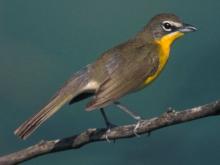
Species Types
Scientific Name
Icteria virens
Description
Our largest warbler, the yellow-breasted chat utters a wide variety of mews, chats, whistles, and stutters. Look for singing males during breeding season. Other times, they hide successfully in brambles and thickets.
Media

Species Types
Scientific Name
Coccothraustes vespertinus
Description
Evening grosbeaks are sporadically present in Missouri — flocks sometimes wander here from the north during winter. When flocks appear at backyard birdfeeders, it creates a local sensation.
See Also







Media

Species Types
Scientific Name
Hemaris diffinis
Description
The snowberry clearwing is a moth that confuses people because it looks like a bumblebee and flies like a hummingbird!
Media

Species Types
Scientific Name
Hyles lineata
Description
The white-lined sphinx moth sometimes confuses people because it flies, hovers, and eats from flowers like a hummingbird. The adults often fly during daylight hours as well as in the night and are often found at lights.
Media

Species Types
Scientific Name
Darapsa myron
Description
The Virginia creeper sphinx moth is common in woods and brushy areas and comes to lights at night. The larvae eat Virginia creeper and grape leaves.
Media

Species Types
Scientific Name
Perimyotis subflavus (formerly Pipistrellus subflavus)
Description
Tri-colored bats, formerly called eastern pipistrelles, are relatively small and look pale yellowish or pale reddish brown. The main hairs are dark gray at the base, broadly banded with yellowish brown, and tipped with dark brown.
Media

Species Types
Scientific Name
Myotis grisescens
Description
Gray myotises are difficult to distinguish from other mouse-eared bats. A key identifying feature of the gray myotis is that its wing is attached to the ankle and not at the base of the toes. It’s an endangered species.
Media

Species Types
Scientific Name
Myotis lucifugus
Description
The little brown myotis (little brown bat) is one of our most common bats, but populations are declining. White-nose syndrome has taken a heavy toll in northeastern states. This species is now listed as vulnerable across its range.
Media

Species Types
Scientific Name
Myotis sodalis
Description
The Indiana myotis, or Indiana bat, summers along streams and rivers in north Missouri, raising its young under the bark of certain trees. It is an endangered species.
About Birds in Missouri
About 350 species of birds are likely to be seen in Missouri, though nearly 400 have been recorded within our borders. Most people know a bird when they see one — it has feathers, wings, and a bill. Birds are warm-blooded, and most species can fly. Many migrate hundreds or thousands of miles. Birds lay hard-shelled eggs (often in a nest), and the parents care for the young. Many communicate with songs and calls.





















